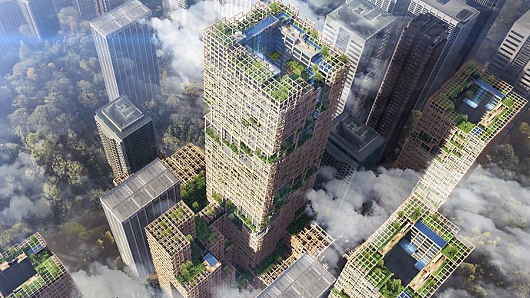Japanese company plans world's tallest wooden building
A Japanese company is planning to build the world's tallest wooden skyscraper with 90 percent of the building made of wood.
Sumitomo Forestry says its wooden high-rise — dubbed the W350 — will be 350 meters tall and the planned structure will be a hybrid of mostly wood and steel.
The 70-storey building, expected to be built in Tokyo, will comprise of stores, offices, hotels and private homes, the company noted in plans released earlier in February.
Sumitomo Forestry, which notes on its website that "happiness grows from trees," said it aimed to create environmentally-friendly, timber-utilizing cities which "become forests through increased use of wooden architecture for high-rise buildings."
Building with wood is still not cheap, however.
Using 185,000 cubic meters of timber, the building is expected to cost around 600 billion Japanese yen ($5.6 billion) which is twice the amount of a conventional high-rise building constructed with current technology.

Sumitomo Forestry
However, the company believed that those costs would come down as timber became a more-frequently used material: "Going forward, the economic feasibility of the project will be enhanced by reducing costs through technological development."
Currently the tallest wooden building is 18-storeys high (53 meters) and serves as accommodation for students at the University of British Colombia.
Greenery will feature heavily in the building from Sumitomo Forestry with foliage connecting from the ground to top floors offering "a view of biopersity in an urban setting."
The building plans show balconies that continue around all four sides of the building, giving a space "in which people can enjoy fresh outside air, rich natural elements and sunshine filtering through foliage."
With earthquakes not unusual in Japan, the building will incorporate a structural system composed of braced tubes made from columns, beams and braces "to prevent deformation of the building due to lateral forces such as earthquakes or wind."
Being a timber building, the risk of fire would seem an obvious concern, but the material's sensitivity to moisture (and potential for warping and distortion) is also a consideration. Sumitomo Forestry said it would "make every effort to further enhance fire and seismic resistance."
Wooden cities
The concept for the building has been prepared primarily at Tsukuba Research Institute, Sumitomo Forestry's research and development facility.
The institute is looking at the "expanding possibilities for wooden buildings as a road map for future technology, such as the development of building methods, environmentally-friendly technologies, and trees that become resources and building materials," the company said.
Sumitomo Forestry can trace its origins in the timber industry back to 1691 and the W350 building is planned to mark the company's 350th anniversary in 2041.
The company notes that forests cover approximately two thirds (68.5 percent) of Japan's land area. This puts it at second place among OECD member countries, behind Finland.
However, the self-supply rate for domestically-produced timber is only at around 30 percent, the company states, and Japan's forests are at risk due to insufficient maintenance.
"Although the large amounts of Japanese cedar and Japanese cypress planted after the Second World War have now reached the time for harvesting, they are being left in an un-maintained state as devastation of our domestic forests continues. It is crucial to use these trees and replant them after harvesting to encourage sustainability of forests," the company said./.
VNF
Recommended
 World
World
India strikes back at terrorists with Operation Sindoor
 World
World
India sending Holy Relics of Lord Buddha to Vietnam a special gesture, has generated tremendous spiritual faith: Kiren Rijiju
 World
World
Why the India-US Sonobuoy Co-Production Agreement Matters
 World
World
Vietnam’s 50-year Reunification Celebration Garners Argentine Press’s Attention
 World
World
"Will continue offering our full support to Indian govt": US FBI Director after Pahalgam attack
 World
World
"Great Leader": JD Vance Lauds PM Modi During His India Visit
 World
World
Trump’s Tariff Pause: A Strategic Move from “The Art of the Deal”?
 World
World
